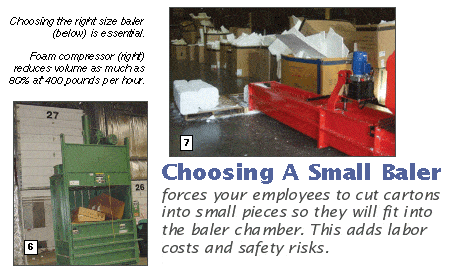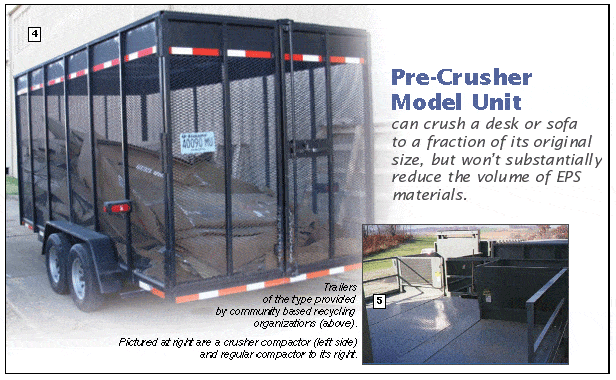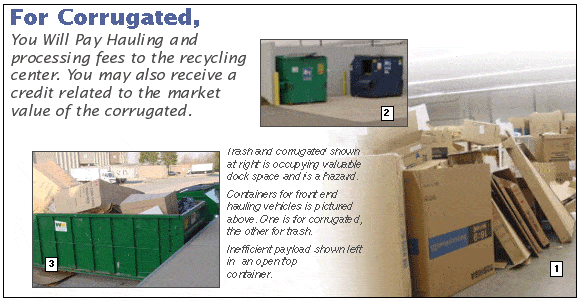Ideas for making your corrugated and trash disposal systems more efficient.
Let’s talk about trash. If you are like most furniture retailers, trash and recycling is an area that doesn’t get all that much attention. If you take the time to review the equipment and methods you use to handle excess packaging materials, it is likely that you will find opportunities to reduce costs and provide operational efficiencies in this area, regardless of how up to date you think you are today.
Some communities have minimal regulation for the disposal of packaging materials while others require retailers to segregate dry trash, corrugated, various plastics, pallets/wood frames, mattresses and garbage. Even if your methods necessarily differ from the retail operations featured in this article, it will be useful to consider the ways that they manage the disposal of their packaging materials.

The first step is to understand your own situation by asking the following questions:
•How much dock space is dedicated to waste materials? Hopefully you are not losing labor productivity and working space because the dock is jammed with materials waiting for the trash hauler as pictured in Photo #1.
- Are any materials left in the warehouse overnight?
- How are you being charged for waste removal?
- What are your annual costs?
- What community resources are available to help determine alternative methods?
- What is the payback for each available option?
- Are the internal resources available to
Determine best options or can outside expertise provide more timely and efficient solutions?
Some communities will provide free pickup of almost any amount or type of trash you generate, while others offer free pickup for corrugated and charge for everything else.
As a commercial enterprise, you may be required to contract for trash hauling with a private company. Competition between trash haulers may provide opportunities to bid your requirements.

Small retailers using the type of trash containers shown in Photo #2 are typically charged by the number of pickups scheduled each week. Trash from these may go to a local landfill or be hauled to a transfer station for costly transport to a remote location.
Nationally, corrugated is the most recycled commodity. In contrast, there are limited opportunities for recycling plastic film and the ever-increasing amounts of EPS (Expanded Poly Styrene).
Possibly the least efficient method of handling waste materials is in open roll off containers pictured in Photo #3. You don’t get a lot of material in this type of container and loading them can present an employee safety hazard.
For waste materials, your charge will be based on the hauling fee and the per ton disposal fee. For corrugated, you will pay hauling and processing fees to the recycling center. You may also receive a credit related to the market value of the corrugated.
A nearby local recycling center may provide trailers like the one shown in Photo #4. These trailers free up dock space and improve housekeeping. Sometimes operated by a charitable organization, the loose corrugated provides income to these centers, as well as local employment for their workers and savings for you. By using them, you can typically shave one-third off of the cost of sending your corrugated to a landfill.

The value of the corrugated depends on market conditions and distance to mills located domestically or overseas. Unfortunately, many of the domestic mills that processed recycled corrugated have closed, but our current trade imbalance has kept the relative price of transporting the material to offshore paper mills for recycling, low.
Once you’ve surveyed your current operation and have a handle on your disposal costs and local options, your next step up is to consider separate compactors for corrugated and trash.
Two types of compactors are shown in Photo #5. The one on the right is for corrugated. Its three-yard hopper will accommodate the largest furniture cartons that it compresses into a 40-yard container. Retailers who use this type of compactor incur the same hauling costs per trip as operations that use open top containers but their payload is three to four times greater. The filled container is transported to a commercial recycling center where the material is compressed into large bales that maximize usage of export boxes. If you are fortunate enough to have a recycling mill nearby, the containers may simply be dumped in an open shed. This type of compactor can also be used for regular trash with similar savings in transport.
The compactor on the left is a pre-crusher model that presses everything against a large steel gate before pushing the product into the 40 yard container. This unit can crush a desk or sofa to a fraction of its original size but won’t substantially reduce the volume of EPS materials. An alternative is a screw type compactor that does a reasonable job on virtually all disposal items, including mattresses, if these are permitted in your local landfill.
Three big advantages of using compactors for corrugated and waste items are that they use a minimum amount of labor, free up dock space, and improve housekeeping as no materials are left in the facility overnight.
Another option you may want to consider for your disposal of corrugated is baling. The two most common mistakes retailers make when choosing a baler is buying a unit that is too small, and failure to understand paper market conditions. Choosing a small baler forces your employees to cut cartons into small pieces so they will fit into the baler chamber. This adds labor costs and increases safety risks. If you have a small baler, make sure that appropriate safety gloves are used to minimize hand injuries.
Photo #6 shows an efficient retail operation that is currently generating income. Keep in mind that fire regulations will limit the amount of corrugated that can be stored inside your building. You may need to have a trailer available to store excess material at the docks.
If you have lots of cheap storage space, you may be able to hold excess corrugated to maximize revenue by taking advantage of price fluctuations in the recycled paper market.
Large volume corrugated generators may use a shredder baler that makes commercial size bales. These units should be located in an area where the dust and noise do not interfere with prep and shop operations. Shredders are also an option for large volume bedding retailers.
Expanded polystyrene (EPS) is an excellent candidate for recycling but transportation costs to ship this material to a recovery center must be given close scrutiny. A USA map showing commercial locations is available at www.epspackaging.org/info.html. Large volume retailers are installing on site machines that reduce EPS by as much as 80%. Photo #7 shows EPS packaging materials in boxes behind a screw type machine and about 1,000 pounds of compressed material on a skid. The installed cost of this unit is about $60,000 and requires 300 square feet. These bales have a variety of saleable uses, domestic and offshore. Manufactured in Denmark, this company has USA representation. You can go to http://www.runi.dk/runi2/uk/epsMenu.htm to get more information.
Plastic film recycling also presents an opportunity for retailers with challenges similar to handling EPS materials (storage and transportation issues). Some retailers who have switched from baling corrugated to compactors are using their small baler to compress plastic film. Additional information on film recycling is available at www.plasticsresource.com/ .
Bottom line, this article only highlights some of the equipment and processes that are helping retailers improve the productivity, safety and economics for trash and recycling. Future articles will revisit this important area. The ideas are there for you to recycle. The opportunities are there for you to capture.
Daniel Bolger, P.E. provides operations consulting services to clients throughout North America. He will be speaking on High Performance Warehouse and Delivery at the NHFA Resource Center during the High Point Market on Friday April 28 at 4 PM. He will also be participating in PROFITSystem’s client conference (PROFITuniversity) on June 13-16 in Las Vegas. You can contact Dan at bolger@furninfo.com or call him direct at 740-503-8875 for more information on this or other transportation, logistics and furniture warehousing topics.